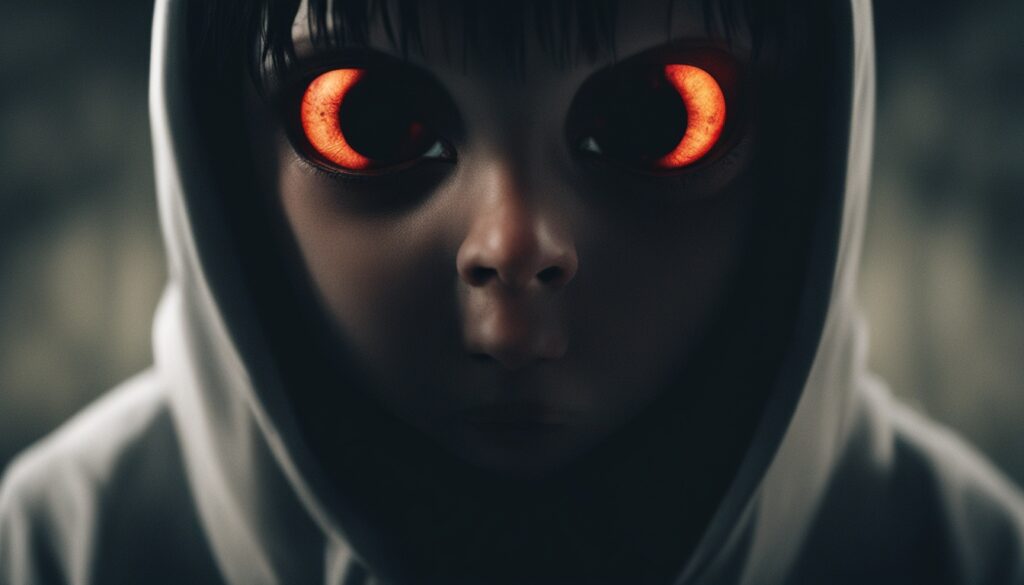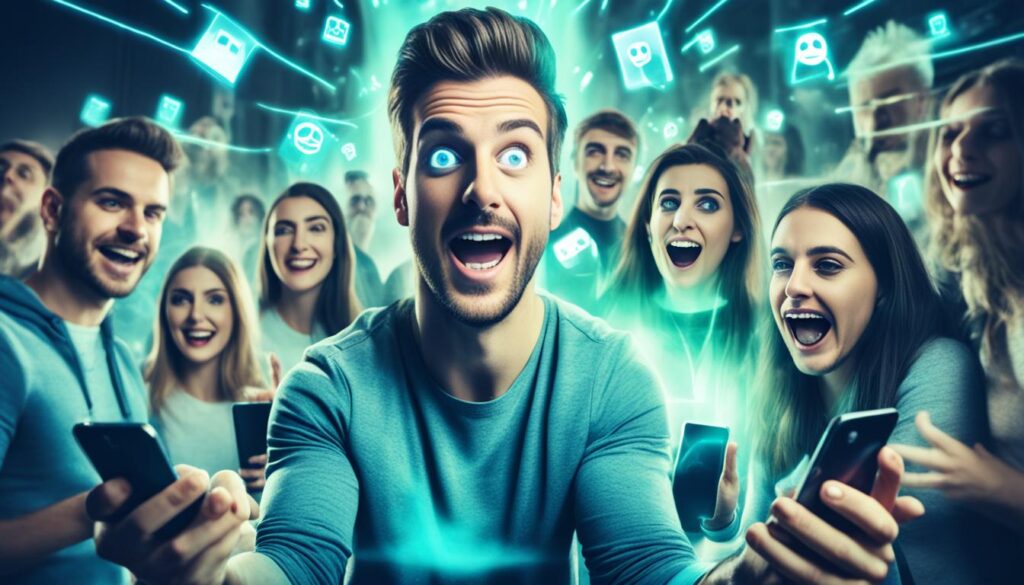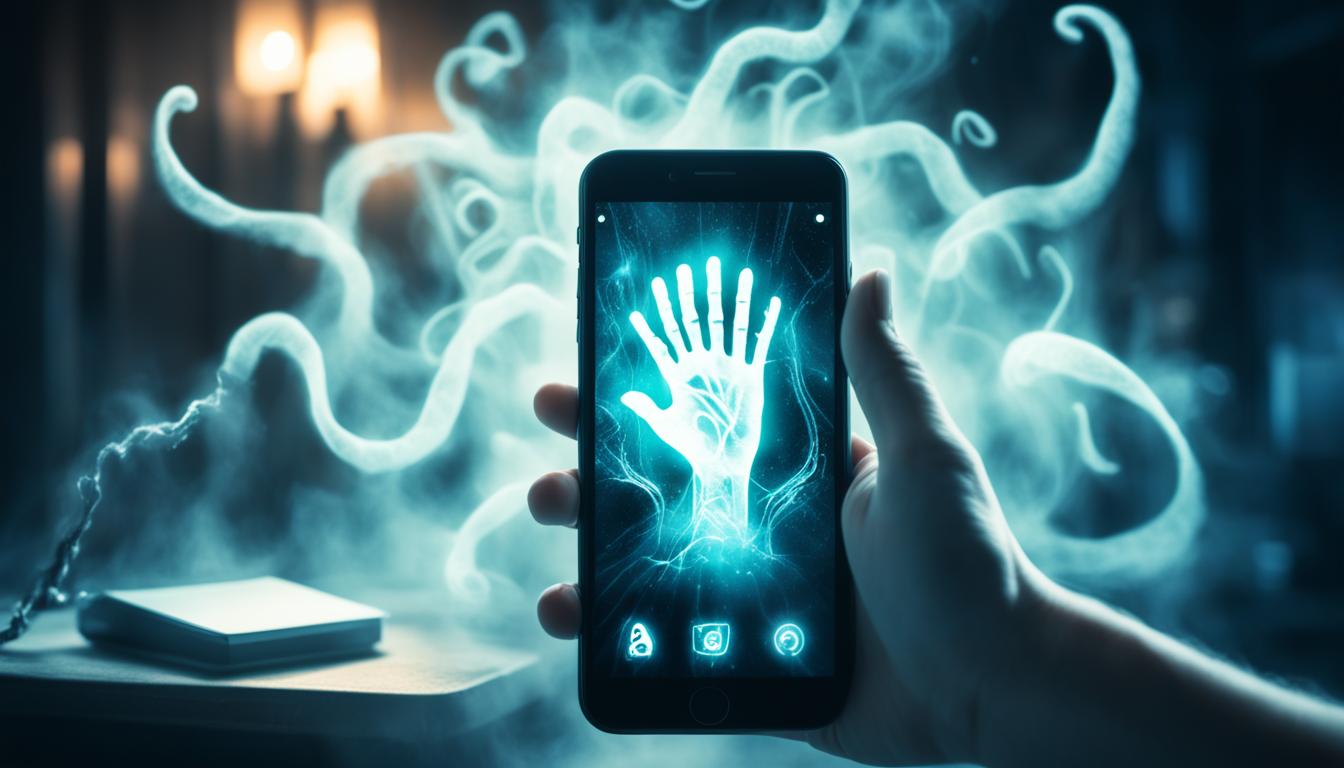During the COVID-19 pandemic, something strange happened on social media. People became really interested in the paranormal. They shared ghost stories and mysteries online, showing our deep fears and worries.
Challenges like the “Blue Whale” and “Momo” became huge hits. People also kept talking about haunted places and mysterious creatures. These stories are like the new tales we tell around a campfire today.
These stories spread fast on social media. They show how our minds work together to shape what we believe. In a world that feels out of control, these supernatural stories offer a way to cope. They let us deal with things we don’t understand.
Key Takeaways
- The COVID-19 pandemic made people really into paranormal trends on social media.
- Stories about ghosts and mysteries caught everyone’s attention.
- These online stories reflect our deep fears and worries, just like old campfire tales.
- They spread quickly online, showing how our minds work together to shape beliefs.
- The supernatural offers a way to escape and understand the unknown.
The Enduring Allure of Ghost Stories
For centuries, ghost stories and urban legends have captured our imaginations. They’ve been passed down through generations, changing to reflect the times. These tales, from campfire stories to modern legends, play on our fear of the unknown. They offer a mix of thrill and comfort, keeping their core themes despite changing details.
Exploring the Timeless Appeal of Spooky Tales
“Chasing Ghosts” by Marc Hartzman looks into the history of ghost hunting. It shows how early societies used shamans and priests to connect with the dead. The 19th century saw a big interest in ghost hunting with spiritualism, a movement that aimed to talk to the dead through mediums like the Fox sisters.
Today, paranormal investigations are popular thanks to reality TV, movies, and books. This has made ghost hunting a big part of popular culture. These spooky tales keep us scared and curious, influencing books, movies, and even tourism.
“The ghost hunting experience is considered a form of dark tourism due to its connection to dark narratives and human tragedy.”
Ghost hunting events are now a big part of paranormal tourism. They use media’s dark stories to draw people in. These events often include tours, meetings with mediums, vigils, and the use of ghost hunting tools like Ouija Boards.
The lasting charm of ghost stories and urban legends comes from their ability to touch our deepest fears and interests. As technology changes our lives, these spooky tales show the lasting power of our imagination.
The Rise of Digital Ghost Stories
In today’s digital world, ghost stories have changed a lot. New tech has made these stories more popular and far-reaching. Now, they move fast around the world, reaching us quickly without the usual media checks.
The “Blue Whale” and “Momo” challenges show how fast and far these stories can go. They start small but quickly spread, causing fear and panic. This shows how fast our beliefs can change because of technology.
How New Technologies Have Amplified the Spread of Paranormal Narratives
Social media, online forums, and video sites have changed how we hear and share ghost stories. These places let people share and talk about these stories. They also let people create their own spooky tales.
- Haunted TikTok (#HorrorTikTok, #CursedTikTok, #GhostTikTok, #CreepyTikTok, #ScaryTikTok) gets one to 11 billion views, not counting untagged videos.
- The @where_is_everybody account on TikTok has over 240,000 followers, drawing people in with its spooky stories.
- Creepypasta stories started with amateur writers on Reddit and have become very popular, being turned into different kinds of media.
- The internet has made horror stories and legends spread fast. For example, Slenderman, a tall, faceless figure in a black suit, is shown in fake videos online.
These digital ghost stories show how powerful social media is in changing what we believe. As reality and fiction mix, these stories are having a big effect on how we see the world.
| Paranormal Trend | Data Points |
|---|---|
| Increase in Paranormal Experiences |
|
| Rise in Paranormal Interest |
|
| Implications of the Paranormal Trend |
|
The digital world keeps changing, and so will the way we see and experience ghost stories. These stories can really grab our attention, scare us, and even change what we believe. This shows how big an impact new tech has on our culture.
Case Study: The Blue Whale Challenge
The “Blue Whale” challenge caught everyone’s attention a few years back. It was said to be an online game that drew in teens with dangerous tasks, ending in a fatal command. Even though there was no solid proof it existed, the story spread fast online, causing a lot of worry among parents and teachers.
This challenge shows how online stories can grab our attention, even if they’re not true. The game supposedly started in Russia in 2016, with a 50-day plan that led to harm and suicide. Some teens did take their lives, but it’s unclear if the game directly caused it.
Despite this, the game got a lot of attention worldwide. Many countries like Egypt, Kenya, and Pakistan banned it, but stopping it might be hard. In Russia, people were arrested for pushing teens to suicide through this game. In India, laws were made to punish those promoting such harmful online acts.
The Blue Whale challenge also led to more self-harm and copycat groups, worrying about cyberbullying and online shaming of kids. It’s said hundreds of deaths were linked to this “suicide game,” with 130 kids possibly taking their lives from November 2015 to April 2016.
To fight this, groups like Baleia Rosa and Capivara Amarela in Brazil started. They focus on positive tasks and helping those in need. Schools also began teaching about the dangers of the Blue Whale challenge to prevent more tragedies.
| Key Incidents Related to the Blue Whale Challenge | Location | Year |
|---|---|---|
| 16-year-old girl killed herself after engaging in the Blue Whale challenge | Georgia, US | N/A |
| Boy named Isaiah Gonzalez died by suicide allegedly linked to the Blue Whale challenge | United States | N/A |
| 19-year-old died by suicide allegedly linked to the Blue Whale challenge | Hyderabad, India | N/A |
| 21-year-old Philipp Budeikin arrested and charged with inciting teenagers to suicide in relation to the Blue Whale challenge | Russia | N/A |
The Blue Whale challenge reminds us of the dangers of online games and the need to focus on mental health and cyberbullying. It’s important to protect vulnerable teens from harmful digital content.
Case Study: The Momo Challenge
The “Momo Challenge” was a scary story that spread fast on social media. It was about a creepy character in kids’ videos on YouTube, giving out scary challenges. Even though there was no proof that Momo was really in these videos, many people believed it, causing warnings from schools and the media.
This challenge shows how fast and far fear can spread online. In July 2018, reports said kids in South America and India hurt themselves because of the Momo Challenge. Police in many countries, like Argentina, Germany, and the U.S., warned people about it.
Examining the Viral Panic Surrounding the Creepy Character
By September 2018, most “Momo” phone numbers were gone, and news about it slowed down. But in the U.S., the fear about Momo peaked in one week, especially after kids’ videos on YouTube mentioned it. A tweet about Momo dangers got over 25,000 retweets quickly.
A news segment about Momo in Salt Lake City was shared a lot on Facebook, with many comments. The warnings about Momo got attention from big news outlets like CBS News and The TODAY Show. Even though there was no proof of harm, the panic shows how fast and far scary stories can go online.

“The Momo Challenge highlights how the fear and anxiety surrounding the safety of children in the digital age can fuel the rapid spread of these digital ghost stories.”
Paranormal Trends on Social Media
Social media is now a hotspot for paranormal stories. You can find everything from ghost tales to UFO sightings on platforms like TikTok, Twitter, and Reddit. These stories spread fast, often without checking if they’re true. This has made them very popular and increased our interest in the unknown.
Paranormal trends are booming online. For example, searches for “real ghost videos” or “UFO sightings near me” jumped by 200% in just 48 hours after news coverage. Searches for “how to communicate with spirits” and “local haunted places” also soared by 300% in one day after an event. Websites and channels that focus on local searches, like “near me” SEO tactics, add to the excitement.
| Paranormal Trend | Search Increase |
|---|---|
| “real ghost videos” | 200% in 48 hours |
| “UFO sightings near me” | 200% in 48 hours |
| “how to communicate with spirits” | 300% in 24 hours |
| “local haunted places” | 300% in 24 hours |
Paranormal content on social media is a big hit. Channels focused on ghost hunting, UFO sightings, and cryptid tracking get millions of views. They create communities of people who love the supernatural. Keywords like “haunted places near me” or “real ghost sightings” help SEO services make these topics more visible, drawing in more fans.
These trends come and go, often tied to cultural or media events. Studies show that over 90% of American adults believe in paranormal phenomena. This belief has grown in recent years. Social media’s power to spread these stories has made the internet a place where the supernatural thrives.
Social media keeps shaping what we’re interested in, and the paranormal is still a big part of that. Whether it’s ghost stories, UFO sightings, or cryptid encounters, these tales capture our attention online. They keep us curious about the mysteries of the world.
Reflecting Our Deepest Fears
Social media’s fascination with the paranormal shows us a lot about being human. We’re drawn to the unknown, trying to understand what we can’t explain. These online ghost stories reflect our deepest worries and fears.
Our fears range from technology to our kids’ safety and feeling out of control. These stories hit us on a deep level. By looking at what grabs our attention, we learn about what worries us as a society.
The Evolving Language of Horror
Horror movies have changed over the years, showing us what scares us. In the 1980s, films were all about grotesque and violent themes, reflecting the era’s fears. The ’90s brought more extreme and ironic horror to entertain a tough audience.
Today, ghost stories are everywhere in horror movies, just like slashers were back then. The “The Conjuring” franchise’s huge success shows we’re really into the paranormal now.
The Rise of Ghosting
Ghosting isn’t just in movies; it’s happening in real life too. It means ignoring someone or pretending you don’t know them. This behavior is more common thanks to dating apps and social media.
The internet and the pandemic have made ghosting more common. It’s about avoiding tough conversations and unclear rejections. This shows our deep worries about connecting with others and facing problems.
“The popularity of paranormal trends on social media reflects a deeper underlying truth about the human condition – we are drawn to the strange and mysterious, and we seek to make sense of the unexplained.”
Looking into these online ghost stories helps us understand ourselves better. It shows us what worries us and shapes our thoughts and actions today.
The Collective Human Hivemind
Humans are naturally social, and our thoughts and actions are shaped by the collective hive mind. We often follow the thoughts and opinions of others, thanks to neural synchrony and the availability cascade. This collective psychology helps spread paranormal stories on social media. We share and engage with stories that match our fears and anxieties, even if they’re not true.
Understanding the Role of Social Synchronization in Shaping Beliefs
Social synchronization makes us want to believe what others believe. Seeing our friends and family accept a story makes us more likely to believe it too, even if it’s not supported by facts. This hive mentality gets stronger on social media, where stories can spread fast and become accepted, even if they’re not true.
| Phenomenon | Description | Impact on Beliefs |
|---|---|---|
| Neural Synchrony | The alignment of brain activity between individuals during social interactions. | Facilitates the sharing and reinforcement of beliefs within a group. |
| Availability Cascade | The self-reinforcing process by which a collective belief or perception gains more and more plausibility through its increasing repetition in public discourse. | Promotes the widespread acceptance of narratives, even in the absence of strong evidence. |
| Collective Psychology | The tendency of individuals to conform to the beliefs and behaviors of the group they identify with. | Shapes the collective beliefs and attitudes within a social network or community. |
Understanding social synchronization helps us navigate online discussions better. It’s important to know how our beliefs are shaped, as the truth and fiction can mix online.
“The hive mind is a powerful force, shaping our beliefs and behaviors in ways we often fail to recognize. By studying the underlying mechanisms, we can learn to think more critically and resist the pull of the collective.”
The Availability Cascade and Group Polarization
The fast spread of ghost stories on social media comes from two main psychological effects: the availability cascade and group polarization. The availability cascade makes us think something is true just because we hear it a lot, even if it’s not true. As these stories get shared and talked about, we start to believe them more, a process called group polarization.
This cycle can turn a small truth into a big digital ghost story fast. It changes how we see and interact with the world. The availability cascade and group polarization shape our collective beliefs about ghosts and the world.
“Children are more likely to believe literal ghost stories than adults. Adults spread their own tales of supernatural occurrences, with narratives evolving over time but maintaining a similar structure.”
Digital technology has made these effects even stronger. New tech has spread stories like the “Blue Whale” and “Momo” challenges widely, even though they turned out to be mostly false.
These stories can cause panic, especially when trusted sources warn us before facts come out. This shows how the availability cascade and group polarization influence what we believe and think.

Knowing how the availability cascade and group polarization work is key to handling social media and ghost stories. By understanding these effects, we can be more critical of the information we see. This helps us build a society that’s better informed and stronger.
Technology Fear: A Recurring Narrative
Throughout history, new technologies have brought both wonder and worry. The printing press and the internet are examples. Each time, people have felt both amazed and cautious.
As Vaughan Bell notes, “From a historical perspective, what strikes home is not the evolution of these social concerns, but their similarity from one century to the next.” Many think technology, especially social media, is bad or addictive. This shows a deep need to blame changes in society on something clear.
Moral Panics and New Technologies
New technologies have often faced moral panics. In 1474, scribes in Genoa worried the printing press would make them jobless. Musicians in the 1930s saw recorded music as a threat to live shows. A German musicologist in 1954 thought synthesizers would destroy music.
The telegraph and telephone were once seen as tools for spreading gossip and lies. Now, with digital photos and social media, worries about privacy and watching over us have grown.
These patterns of technology fear and moral panics show how we often blame new innovations for our worries.
“Each new technology, from the internet to mobile phones, has been met with a mix of wonder and wariness.”
The fear of technology’s effect on us shows a deep need to blame changes in society on something clear. But, understanding the complex link between technology and our well-being is key to moving past these simple stories.
Rethinking Social Media’s Impact
Instead of spreading fear about the social media impact, we should look at it with a nuanced understanding. Research shows that social media doesn’t always harm mental health. It depends on the person, how they use it, and the platforms they choose.
Looking past the idea of “technology addiction” helps us see the real connection between digital tools and our actions. This leads to finding ways to use these tools in a good way.
Embracing Complexity
Social media’s effects are complex and can’t be summed up in one story. Studies on the brain show how people’s brains and feelings affect their social media use. Also, the competition to get followers and make interesting content shows how power and influence work in our society.
By recognizing these complexities, we can avoid simple answers. We can work towards a deeper, fact-based understanding of social media’s role in our lives.
Conclusion
Exploring the world of paranormal trends and digital ghost stories shows how much we love the strange and unknown. These stories, like the Blue Whale and Momo challenges, reflect our deepest fears and worries. They act as a mirror to our society’s anxieties.
By looking into the reasons behind these stories, we can see beyond simple tales. We can learn to think more deeply about how technology affects us. The rise of these stories shows our constant need to understand the unknown. It also highlights how our collective thoughts shape our beliefs.
In today’s digital world, it’s key to keep an open mind and not blame everything on easy targets. By understanding how paranormal trends, social media, and our minds work together, we can learn important lessons. These lessons will help us navigate the changing world we live in.
FAQ
What is the recent surge in interest in the paranormal on social media?
The COVID-19 pandemic made us all turn to the paranormal for excitement. Now, ghost stories and UFO sightings are everywhere online. This shows how our deep fears and anxieties shape what we believe and think.
Why have ghost stories and urban legends continued to fascinate us throughout history?
For centuries, ghost stories have scared and thrilled us. They tap into our fear of the unknown. Even as they change, their core themes stay the same, offering both thrill and comfort.
How have digital technologies transformed the way paranormal narratives are shared and amplified?
Digital tech has made it easier for ghost stories to spread fast. Social media and online forums let these tales go viral. This has made the paranormal more popular and interesting to us all.
What was the “Blue Whale” challenge and how did it captivate the public’s imagination?
The “Blue Whale” challenge was a scary online game. It was said to lure teens into dangerous tasks, ending in a deadly dare. Though not proven, it spread fast online, causing panic among parents and teachers.
What was the “Momo” challenge and how did it contribute to the viral panic surrounding digital ghost stories?
The “Momo” challenge was another online scare. It involved a creepy character in kids’ videos, giving out scary tasks. Despite no proof, it got a lot of attention, leading to warnings from schools and media.
What other paranormal trends have gained popularity on social media?
Social media is full of paranormal trends now. From ghost stories to UFO sightings, these tales are everywhere. Platforms like TikTok and Reddit have made them even more popular.
How do paranormal trends on social media reflect our deepest societal fears and anxieties?
These online ghost stories reflect our biggest fears, like tech worries and child safety. They show how our anxieties shape our beliefs and perceptions.
What role does collective human psychology play in the spread and acceptance of paranormal narratives on social media?
Our psychology plays a big part in sharing and believing in these stories. Things like the availability cascade and group polarization make them spread fast. This shows how our minds work together online.
Why do we often attribute societal changes and anxieties to technology as a scapegoat?
We often blame new tech for society’s problems. This is because it’s easy to point to something concrete for our worries. It’s a way to simplify complex issues.
How can we move beyond simplistic narratives and gain a more nuanced understanding of the impact of social media and technology?
We need to look deeper into how social media affects us. Research shows it’s not all bad for our mental health. By understanding tech better, we can use it in a good way.
Source Links
- How Ghost Stories Spread in the Era of Social Media – https://lithub.com/how-ghost-stories-spread-in-the-era-of-social-media/
- Experts explain our love of fear and fascination with the supernatural – https://news.arizona.edu/news/experts-explain-our-love-fear-and-fascination-supernatural
- Paranormal news & latest pictures from Newsweek.com – https://www.newsweek.com/topic/paranormal
- Chasing Ghosts Summary PDF | Marc Hartzman – https://www.bookey.app/book/chasing-ghosts
- PDF – https://rgu-repository.worktribe.com/OutputFile/2348913
- An Interview with David Goulden- Paranormal Events Manager at Nothe Fort by Haunted History Chronicles – https://podcasters.spotify.com/pod/show/hauntedchronicles/episodes/An-Interview-with-David-Goulden–Paranormal-Events-Manager-at-Nothe-Fort-e1mnapr
- Spooky Britain: how ghosts became a national obsession – https://www.theguardian.com/lifeandstyle/2022/apr/06/spooky-britain-how-ghosts-became-a-national-obsession
- Haunted TikTok Is The Next Evolution Of Internet Horror – https://in.mashable.com/culture/15774/haunted-tiktok-is-the-next-evolution-of-internet-horror
- What Are Your Experiences With Internet-Based Urban Legends? – https://archive.nytimes.com/learning.blogs.nytimes.com/2014/06/09/what-are-your-experiences-with-internet-based-urban-legends/
- Blue Whale Challenge – https://en.wikipedia.org/wiki/Blue_Whale_Challenge
- Blue Whale: What is the truth behind an online ‘suicide challenge’? – https://www.bbc.com/news/blogs-trending-46505722
- Blue Whale: Blue Whale Challenge and other ‘games’ of death – https://m.economictimes.com/magazines/panache/blue-whale-challenge-and-other-games-of-death/articleshow/60135835.cms
- Momo Challenge hoax – https://en.wikipedia.org/wiki/Momo_Challenge_hoax
- How ‘Momo,’ a social media hoax about a paranormal threat to kids, went viral in U.S. – https://www.nbcnews.com/tech/tech-news/how-momo-global-social-media-hoax-about-paranormal-threat-kids-n977961
- Exploring the Influence of Paranormal Phenomena on Search Trends – https://www.extrastrength.com.au/article/exploring-the-influence-of-paranormal-phenomena-on-search-trends
- SOCIAL INFLUENCE ON PARANORMAL BELIEFS – https://scholarcommons.sc.edu/cgi/viewcontent.cgi?referer=&httpsredir=1&article=1003&context=socy_facpub
- Don’t Look in the Mirror – https://medium.com/amusing-responses/dont-look-in-the-mirror-db82e9cfb174
- Why Can’t We Give Up the Ghosting? – https://www.nytimes.com/2023/10/31/t-magazine/ghosting-dating-relationships.html
- NWSH is back! And in 2021, there are ghosts to be slayed 👻 – https://www.linkedin.com/pulse/nwsh-back-2021-ghosts-slayed-david-mattin
- Top Social Media Trends of 2023: Roman Empire, Grimace Shake, Keith Lee and More – https://www.nytimes.com/2023/12/20/style/social-media-tiktok-news-trends-2023.html
- Climate change availability cascade – https://judithcurry.com/2015/04/09/climate-change-availability-cascade/
- Innovations and Outcries: Echoes of Technophobia Through Time – https://medium.com/@mizcausevic/innovations-and-outcries-echoes-of-technophobia-through-time-81cf74ccb27f
- FROM TV TO TIKTOK: WHAT TECHNOLOGY IN HORROR FILM SHOWS ABOUT SOCIETY’S SHIFTING FEARS – https://epublications.regis.edu/cgi/viewcontent.cgi?article=2082&context=theses
- Supernatural Beliefs and the Influence of the Media – https://huskiecommons.lib.niu.edu/cgi/viewcontent.cgi?article=2065&context=studentengagement-honorscapstones
- The Virtual Colosseum: Overcoming Social Media’s Dark Side – https://medium.com/@FrankCastro/the-virtual-colosseum-overcoming-social-media-s-dark-side-c303db23d805
- The Reason Your Social Media Isn’t Working! – https://www.linkedin.com/pulse/reason-your-social-media-isnt-working-jenn-donovan
- The Forensic Mental Health Implications of Social Media Challenges – https://jaapl.org/content/early/2024/02/21/JAAPL.230114-23
- The influence of The Type of Supernatural and Paranormal Media on The Belief in The Various Forms of Supernatural and Paranormal Phenomena – https://huskiecommons.lib.niu.edu/cgi/viewcontent.cgi?article=8086&context=allgraduate-thesesdissertations
- Paranormal beliefs and cognitive function: A systematic review and assessment of study quality across four decades of research – https://www.ncbi.nlm.nih.gov/pmc/articles/PMC9067702/
- Why It’s Normal to Believe in the Paranormal – https://www.psychologytoday.com/us/blog/presence-of-mind/202310/why-its-normal-to-believe-in-the-paranormal

